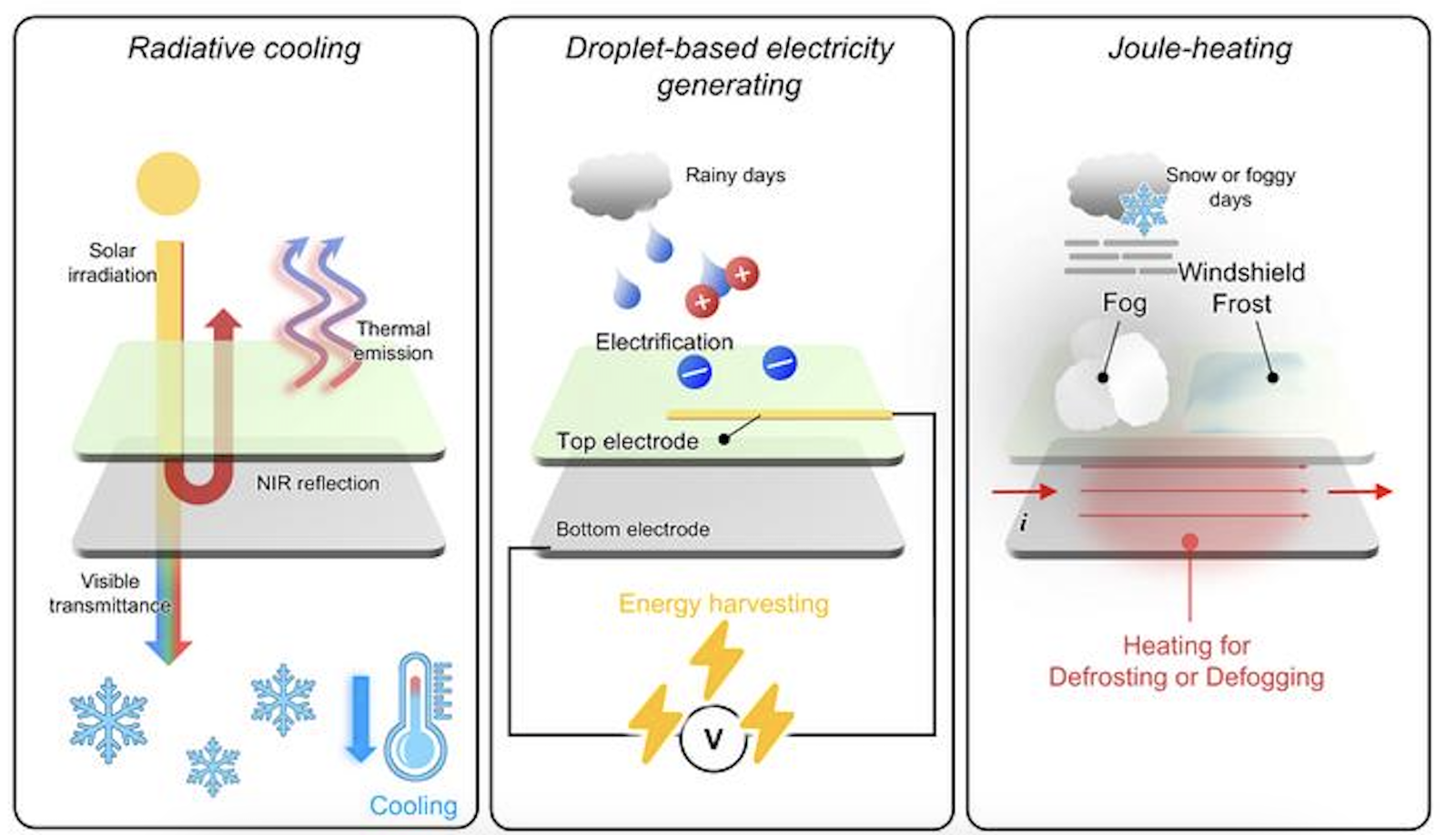As opposed to opaque windows?
Transparent vs translucent.
frosted glass exists
Someone should explain why this is ludicrous.
I had the same thought. Predicably, someone did ☝️
Raindrop energy harvesting is a rubbish idea. The raindrops simply don’t have a meaningful amount of energy to begin with: https://news.ycombinator.com/item?id=36907674
Yeah, the whole article is a bit fishy:
In addition to generating clean electricity, the new ITO-silver window coating creates a cooling effect by allowing only the visible part of the light spectrum to pass inside. Other parts of the spectrum are reflected outside.
So how would a room actively cool down, when you let only the visible light spectrum inside? Sure it might not get as hot as if you let all light inside, but it will also not get colder.
They subscribe to the theory that less forward acceleration is the same thing as slowing down.
Honestly, if this was all it did I’d want it. Our house is south facing and the front of the house gets very hot in summer. Windows that effectively limited the amount of heat that could come through would help a lot - even if, as you say, it doesn’t actively cool
That kind of window has been around for a long time already. Also, let me introduce you to window awnings
not if your getting it anyway. if the cost is worthwhile for the cooling and defrost qualities anyway and you get some energy for free then even a little is fine. Its like the old prius that had solar panels to help with ac but it would not power the car.
if the cost is worthwhile
lol
Yeah but a journalism student just learned the phrase “triple threat” and wanted to shoehorn it into an article
I’m sure his mum pinned it on the fridge
I mean, not in the sense that they’re trying to do it, but that’s ultimately what drives hydroelectric dams.
Sure, but those are completely different approaches. Dams have the advantage that they have a much larger capture area for water and that they can accelerate the water beyond the 10 m/s terminal velocity of raindrops.
We gotta build a reservoir just below cloud level and then put turbines all the way down to sea level to harvest more of the energy
Blimp reservoirs!
Last year the California Energy Commission posted the results of a study aimed at assessing efficiency of deploying piezoelectric systems to generate clean electricity from roadways.
“Based on the laboratory evaluations and road tests, the application of the piezoelectric energy harvesting system in one lane of a one-mile-long roadway has the potential to generate 72,800 kilowatt-hours of energy per year,” the team reported.
How is that clean energy, in any sense of the word? Any system that gains some energy from a passing car must necessarily decrease the (kinetic) energy of the car by an equal or greater amount. And the vast majority of cars get their kinetic energy by burning fossil fuels. Sounds like a more expensive, less direct, and less efficient version of a gasoline generator.
How would a turbine that takes energy from the air current generated by a passing car decrease the energy of the car? The car has imparted the energy to the air, the air has already extracted energy from the car aerodynamic or directly Newtonian forces, and then the turbine would extract energy from the accelerated air from the passing vehicles.
IIRC there was a real world test of this idea some time ago and the results weren’t great. But imagine you do this in a tunnel- that will help improve the results and answer your question.
If you’ve ever been in a subway you’ve probably noticed the train pushes a wall of air ahead of itself. This is the energy you would need to capture. But by “capturing” it, you would inherently increase resistance on the airflow, and therefore the vehicle.
The reason you can’t imagine this being an issue in a typical roadside is the same reason the effect yields poor results. There is little in the way of channeling the air across the turbines, which also means there is little resistance on the passing vehicles. Of course the air in the atmosphere, pushing against the air your car moves ahead of itself, is the classic example of this overall effect.
How would a turbine that takes energy from the air current generated by a passing car decrease the energy of the car?
Not sure where you got that idea from, but how would that generate a meaningful amount of energy? It seems very unlikely that such a system would ever recover the energy spent on its construction.
Not sure where you got that idea from
I think it’s because you said, “Any system that gains some energy from a passing car,” not that anyone mentioned turbines explicitly.
It depends. Is this energy the same energy that is already being burned?
Looking at an extremely simple example: Solar powered calculators (the real ones). They harness light from the light bulbs in a room which would be otherwise dark. The only time they are harnessing that power, is when the light is on. They add no extra draw to the light, they are 100% passive. The only time you’d really have to take into consideration how green that power is (explicitly for the calculator) is if you are turning on that light explicitly to power the calculator.
If the tech being talked about is just harnessing the “junk energy” of the vehicles in their normal operation, this would be 100% green energy. If it is adding a load, it is 100% dirty when powered by an ICE. If it’s somewhere in the middle… I hope you get my point.
You’re also ignoring the fact that not all vehicles are ICE.
That’s a fair point, a device could theoretically harvest energy that would have otherwise been wasted, and that would be green energy. I imagine a wind system could work, though it might result in cars experiencing additional drag from slower wind speeds.
However, the piezoelectric generators mentioned in the article quite clearly do not use waste energy. They compress under the weight of the cars, turning a small amount of gravitational potential energy into electricity. That energy must be made up with extra fuel.
Finally, even if all of the vehicles on the road were powered by clean electricity, it would still be a useless system. Piezoelectrics are nowhere near 100% efficient, so you’re just taking electricity from the vehicles at a loss.
I mean, I can think of many ideal places for such things. Intersections for instance, where cars will be wanting to slow down or come to a stop regardless. Speed limit changes, where you want cars to slow down. Even in place of speed bumps, assuming you can get enough of a drag on the car to effect a slow down.
Ehh it’s still a rubbish idea, that money would be much better spent going after primary producers of energy, like solar, wind, geothermal, or nuclear.
Some napkin math and an equivalent area of solar, say over a road or parking lot would produce 3.5 million kwh in a year.
Those aren’t always a fit for everywhere. And getting energy from one place to another is an unsolved issue. Just because one option is cheaper than others doesn’t mean that particular option is the better choice. Diversity is very important.
What kind of junk energy is there to harvest from a car (in meaningful amounts)? I guess breaking is the obvious answer, but that’s already covered by regenerative breaking. Most car-based energy harvesting systems seem to employ speedbumps that clearly take useful (kinetic) energy away from the car (probably at a very poor efficiency).
I cleaned my windows yesterday. Now I can finally see the outside through them.
They actually got better? Nice work
I always liked motioneye os
If this tech is real, maybe we’ll see it in Los Angeles area apartments in 3050









